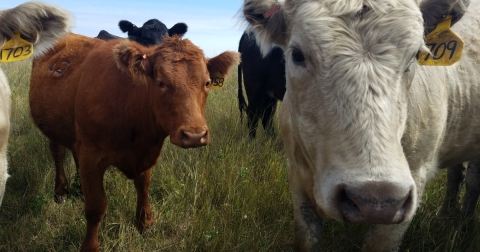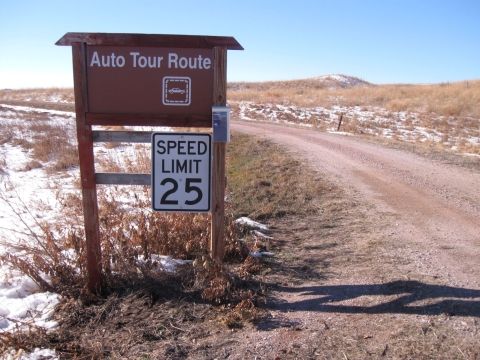There are two Research Natural Areas on the Refuge which are open to public use and research. In 1979 the Refuge became a Registered Natural Landmark, and in 2005, Valentine National Wildlife Refuge was designated a Nebraska Important Bird Area by the Audubon Society. The Important Bird Area program is an inventory of the key sites within a state that support a significant number of birds, and a high diversity of birds.
Whether it's bird watching, fishing, walking, hiking, touring, or hunting, Valentine National Wildlife Refuge is the perfect place to enjoy the great outdoors!
Visit Us
Pristine lakes, vast expanses of native prairie, and abundant fish and wildlife provide great opportunities to bird watch, hike, hunt, and fish. One of the many ways to experience the vastness of the prairie is from the observation deck located on the old fire tower at the west end of Hackberry Lake. Visitors also enjoy our sharp-tailed grouse lek viewing blinds for the spring mating dances in April.
The Valentine National Wildlife Refuge office is located 30 miles south of the town of Valentine on US Highway 83, then 1 mile east on Pony Lake Road. The highway turn off is marked with a sign. Office hours are 8:00 AM to 4:30 PM, Monday through Friday, excluding Federal holidays. Call ahead to assure that staff is available at the office.
Valentine National Wildlife Refuge
39679 Pony Lake Road
Valentine, Nebraska 69201
402-376-1889
e-mail us at fortniobrara@fws.gov
Navigating by GPS Enter coordinates:
N 42* 29’ 12.224”
W 100* 31’ 12.28”
The 480 acre Yellowthroat Wildlife Management Area is managed by Refuge staff. It is located 13 miles south of Ainsworth, Nebraska on State Highway 7 and then 1.5 miles east on a primitive gravel road. There is a sign at the highway turn off.
Location and Contact Information
About Us
Refuge Purpose
Each unit of the National Wildlife Refuge System is established to serve a purpose that targets the conservation of native species dependent on its lands and waters. All activities on those acres are reviewed for ensure that they are compatible with the refuge wildlife purpose.
Valentine National Wildlife Refuge strives to preserve, restore, and enhance the ecological integrity of Nebraska Sandhill uplands and associated wetlands as habitat for migratory birds and other indigenous wildlife for the benefit of present and future generations of Americans. The 71,516-acre Valentine NWR is located in the Sandhills of north-central Nebraska. The native grass prairie and wetlands found here support a diversity of wildlife, and little has changed from historic times. The Refuge was established by Congress in 1935 “as a breeding ground for migratory birds and other wildlife.” The Refuge is home to 270 species of birds, 59 species of mammals, and 22 species of reptiles and amphibians.
The Refuge is a unique and ecologically important component of the National Wildlife Refuge System, which includes more than 566 National Wildlife Refuges spanning approximately 100 million acres of lands and 750 million acres of oceans in the United States.
Tours
Explore the beauty of Valentine National Wildlife Refuge on foot or by auto. The Marsh Lakes Overlook trail is a short nature trail with great views of Refuge grasslands and marshes. For more of a challenge, hike to and climb the old fire tower at the Civilian Conservation Corps Nature Trail. Another great option is the 9-mile Little Hay Road Wildlife Drive which traverses the western part of the Refuge. This gravel road passes by three lakes, through high hills, and along meadows and marshes offering opportunities to view wildlife from your vehicle. An interpretive brochure, available at the entrance, provides information on sights you may see along your drive.
What We Do
Wildlife conservation is at the heart of the National Wildlife Refuge System. It drives everything on U.S. Fish and Wildlife Service lands and waters managed within the Refuge System, including the purposes for which a national wildlife refuge national wildlife refuge
A national wildlife refuge is typically a contiguous area of land and water managed by the U.S. Fish and Wildlife Service for the conservation and, where appropriate, restoration of fish, wildlife and plant resources and their habitats for the benefit of present and future generations of Americans.
Learn more about national wildlife refuge is established, the recreational activities offered and the resource management tools used. Using conservation best practices, the Refuge System manages these lands and waters to help ensure the survival of native wildlife species.
Refuge lakes, grasslands, and marshes are managed for the benefit of wildlife using prescribed fire, cattle grazing, water level manipulations, and control of non-native plants and animals. Monitoring and research guide management of Refuge habitats and wildlife.
Our Species
The Refuge is home to 270 species of birds, 59 species of mammals, and 22 species of reptiles and amphibians. Prairie chickens, sharp-tailed grouse, Blanding's turtle and coyote are but a few of the many species of wildlife who utilize and live on Refuge lands.
Projects and Research
Two Research Natural Areas are located on the Refuge; the George Wiseman Natural Area and Natural Area 2. They are located south of Hackberry and Dewey Lakes, have a combined total size of 1,381 acres and are closed to public access. Research Natural Areas preserve plant and animal communities in a natural state for research purposes.









